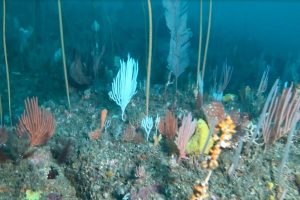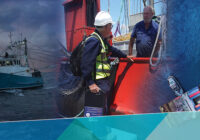A world leading approach to the anchoring of ships has been introduced in Port Kembla to protect the marine life of the region’s rocky reefs.
Recent DPI Fisheries research that found unrestricted anchoring was impacting the seafloor has led to the creation of designated anchorages to better protect marine life of the area.

This image of the rocky reef seafloor off Port Kembla was captured by remotely operated vehicles (ROV) as part of the study into the impact of anchoring on the seafloor (Image – DPI Fisheries)
Every year hundreds of large freight vessels anchor in the open waters near Port Kembla awaiting entrance to the Port.
It is estimated the new designated anchorages will reduce the seafloor impact area by over 45%.
DPI Fisheries Research Scientist Dr Matt Rees was involved in the study looking at how anchors from these vessels were impacting marine life on the seafloor.
What they found was significant.
His team used remotely operated vehicles to survey marine life up to 60 metres deep.
“We found that anchoring by these large vessels reduced the abundance of seafloor life such as sponges by a factor of 7!“
“This is due to anchors dragging across the seafloor as the ships move due to wind and currents, scouring marine life from the area.”
Working with the Port Authority, the team helped design designated anchorages, with the aim of reducing the impact of anchoring without compromising port operations.
Dr Rees said he was excited to see their research used to change anchoring practices in the area for the better.
“It’s fantastic we were able to work with the Port Authority to help create these designated anchorages.”
“Instead of anchoring occurring randomly across the Illawarra coastline these designated anchorages mean there are now only 11 areas subject to anchor scour.”
Dr Rees said the rocky reef seafloor in the Illawarra is an important habitat.
“These reefs are home to a wide variety of sea life much of which was being heavily impacted by large ship anchors,” he said.
“At these depths, marine life on rocky reefs takes a long time to regrow, so protecting these areas is important,“ Dr Rees said.
“This is a win-win for industry and the environment as these new anchorages are not disrupting trade at all, but they are looking after our marine life,” he said.
He said the designated anchorages will allow the marine life outside of these areas to possibly recover.
“We tried to make sure these designated anchorages were in the best possible areas to preserve the seafloor in the area.”
“Now ships are advised to anchor within these designated areas, reducing the anchoring footprint in the area by more than 45%.”
“This is a great outcome for our ocean life. It’s wonderful to be part of the research that has underpinned this,” he said.
This work was conducted in collaboration with the Department of Climate Change, Energy, the Environment and Water (DCCEEW) and the University of Wollongong (UOW).
To hear what the Department of Climate Change, Energy, the Environment and Water (DCCEEW) has to say about their role in this project read their story Science informs ship anchoring.
You can also watch a video about the University of Wollongong’s role in this project Dragging the chain.
This work is part of the DPI Fisheries Review of offshore anchoring project funded via the NSW Marine Estate Management Strategy.







